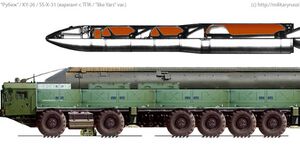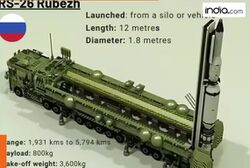آرإس-26 روبيج/روبيژ RS-26 Rubezh
| RS-26 Rubezh | |
|---|---|
 | |
| النوع | intermediate-range ballistic missile |
| مكان الأصل | Russia |
| تاريخ الخدمة | |
| يستخدمه | Russian Strategic Missile Troops |
| تاريخ الانتاج | |
| المصمم | Moscow Institute of Thermal Technology |
| أُنتِج | 2011 |
| المواصفات | |
| الوزن | 36,000 kilograms (80,000 lb) |
| الرأس الحربي | 4x each 150/300 Kt MIRV, payload 800 kilograms (1,800 lb)[1] |
| المحرك | Solid-fueled (last stage or warhead block can have liquid) |
| الدافع | solid, third or fourth stage (warhead block) can be liquid |
المدى العملياتي | 5800 km demonstrated[2] |
| ارتفاع الطيران | Several tens of km |
| السرعة | over Mach 20 (24,500 km/h; 15,200 mph; 6.81 km/s) |
نظام التوجيه | Inertial with GLONASS |
| الدقة | 90-250 m CEP[بحاجة لمصدر] |
منصة الإطلاق | Road-mobile TEL |
The RS-26 Rubezh (روسية: РС-26 Рубеж, meaning frontier or boundary), designated by NATO as SS-X-31,[3] is a Russian solid-fueled intermediate-range ballistic missile with a nuclear warhead, of which the range bracket just barely classifies it as an intercontinental ballistic missile (ICBM). It is equipped with a thermonuclear MIRV or MaRV payload, and is also intended to be capable of carrying the Avangard hypersonic glide vehicle. The RS-26 is based on RS-24 Yars, and constitutes a shorter version of the RS-24 with one fewer stages.[4][5] The development process of the RS-26 has been largely comparable to that of the RSD-10 Pioneer, a shortened derivative of the RT-21 Temp 2S. Deployment of the RS-26 is speculated to have a similar strategic impact as the RSD-10.[6]
التاريخ
After an initial failure in 2011, it was first test-launched successfully from the قاعدة پلستسك الفضائية on May 26, 2012,[7][8] hitting its target at the Kura Range 5,800 km away minutes later. Further successful tests were performed from Kapustin Yar to Sary Shagan in 2012[9][10] and 2013.[11] In 2018, however, it was reported that procurement of the RS-26 by the state armament plan until 2027 (GPV-27) had been frozen, with funding diverted toward continued procurement of the Avangard hypersonic glide vehicle.[12]
الاستخدام العملياتي المزعوم
According to the Ukrainian Air Force and Ukrainska Pravda, on 21 November 2024 the Russian Federation launched an unspecified number of conventional RS-26 missiles at Ukraine, reportedly targeting critical infrastructure in the central Ukrainian city of Dnipro.[13] Russian government spokesperson Dmitry Peskov was asked to confirm this, and at the time, replied that he "had nothing to say on this topic".[14] A western official stated that the missile used in the attack in question was not an ICBM.[15] Later that day, Vladimir Putin confirmed that the strike had indeed not been performed by an ICBM, but a new model of IRBM, the Oreshnik, using a non-nuclear hypersonic payload.[16][17]
انتقادات سياسية
The missile had been criticized by Western defense observers for indirectly breaching the (now defunct) Intermediate-Range Nuclear Forces Treaty (INF Treaty), which prohibited the U.S. and Russia from possessing nuclear and conventional ground-launched ballistic missiles, cruise missiles, and missile launchers with ranges of 500–1,000 kilometers (310–620 mi) (short medium-range) and 1,000–5,500 km (620–3,420 mi) (intermediate-range). The RS-26 missile was demonstrated with a light or no payload, extending its range beyond the proscribed 5500 km limit of the treaty; however, all subsequent tests were flights with significantly shorter ranges that fell within the treaty prohibitions. The RS-26 was twice tested at a distance of about 2000 km.[18] According to a US magazine article, the RS-26 is exactly the same concept and a direct replacement for the RSD-10 Pioneer—known to NATO as the SS-20 Saber—which was banned under the INF treaty.[19]
The RS-26 is designed to pose a strategic threat to European capitals and has the ability to target NATO forces in Western Europe. According to an article by Jeffrey Lewis entitled "The problem with Russia's missiles", the purpose of these weapons is to deter Western forces from coming to the aid of the NATO's newer eastern members that are located closer to Russia's borders.[20]
انظر أيضاً
- Strategic Missile Troops
- RS-28 Sarmat
- R-36 (missile)
- UR-100N
- RT-2PM Topol
- RT-2PM2 Topol-M
- LGM-30 Minuteman
- DF-5
- DF-41
- Agni-V
- Oreshnik (missile)
References
- ^ "Missile Defense Project, "RS-26 Rubezh," Missile Threat, Center for Strategic and International Studies". missilethreat.csis.org. April 23, 2024.
- ^ "RS-26 Rubezh Intercontinental Ballistic Missile". Military-Today.com. Archived from the original on 16 June 2017.
- ^ Kristensen, Hans (7 May 2014). "Russian ICBM Force Modernization: Arms Control Please!". Federation of American Scientists. Retrieved 25 July 2021.
- ^ "RS-26 Rubezh / Avangard - Road Mobile ICBM". GlobalSecurity.org. Retrieved 17 January 2015.
- ^ "Russia's hypersonic trump card edges closer to reality". Russia Beyond. 23 Oct 2013. Archived from the original on 6 September 2017. Retrieved 17 January 2015.
- ^ Forss, Stefan (6 April 2017). "Russia's New Intermediate Range Missiles - Back to the 1970s". Atlantic Council.
- ^ "Russia tests secret missile after Nato shield launched". BBC News. BBC. 23 May 2012. Retrieved 17 January 2015.
- ^ Podvig, Pavel (23 May 2012). "Russia tests prototype of a new ICBM". Russian Strategic Nuclear Forces. Retrieved 17 January 2015.
- ^ "Russia to create new missiles to compete with U.S." Missile Threat. 9 January 2013. Archived from the original on 21 January 2013. Retrieved 17 January 2015.
- ^ Podvig, Pavel (24 Oct 2012). "New ICBM tested in Kapustin Yar". Russian Strategic Nuclear Forces. Retrieved 17 January 2015.
- ^ Podvig, Pavel (6 Jun 2013). "Russia continues tests of new ICBM, named Rubezh". Russian Strategic Nuclear Forces. Retrieved 17 January 2015.
- ^ "Avangard hypersonic missiles replace Rubezh ICBMs in Russia's armament plan through 2027".
- ^ Alona Mazurenko (21 November 2024). "Russians launch Rubezh intercontinental ballistic missile at Ukraine for first time ever". Ukrainska Pravda (in English). Retrieved 21 November 2024.
{{cite web}}: CS1 maint: unrecognized language (link) - ^ Hardaker, Daniel (2024-11-21). "Ukraine-Russia war live: Russia 'fires intercontinental ballistic missile' at Ukraine for first time". The Telegraph (in الإنجليزية البريطانية). ISSN 0307-1235. Retrieved 2024-11-21.
- ^ Radford, Haley; Britzky, Haley (2024-11-21). "The latest on Russia's war in Ukraine: Live updates". CNN (in الإنجليزية). Retrieved 2024-11-21.
- ^ "Ukraine war latest: Putin says Russia hit Ukraine with new intermediate-range ballistic missile". BBC News (in الإنجليزية البريطانية). Retrieved 2024-11-21.
- ^ Sauer, Pjotr; Sabbagh, Dan; Roth, Andrew (2024-11-21). "Putin says Russia fired experimental ballistic missile into Ukraine". The Guardian. Retrieved 2024-11-21.
- ^ "Russia's Rubezh Ballistic Missile Disappears off the Radar". Jamestown.
- ^ Majumdar, Dave (14 February 2017). "Russia's Dangerous Nuclear Forces are Back".
- ^ Lewis, Jeffrey (29 July 2014). "The problem with Russia's missiles". Foreign Policy.
- CS1 الإنجليزية البريطانية-language sources (en-gb)
- مقالات ذات عبارات بحاجة لمصادر
- Articles containing روسية-language text
- Nuclear weapons of Russia
- Intercontinental ballistic missiles of Russia
- Moscow Institute of Thermal Technology products
- Post–Cold War weapons of Russia
- Weapons and ammunition introduced in 2011
- Military equipment introduced in the 2010s
- MIRV capable missiles
